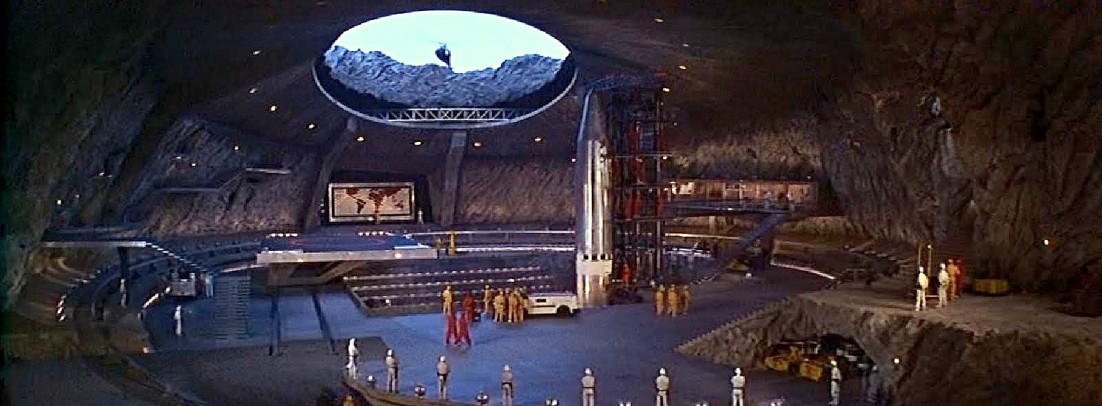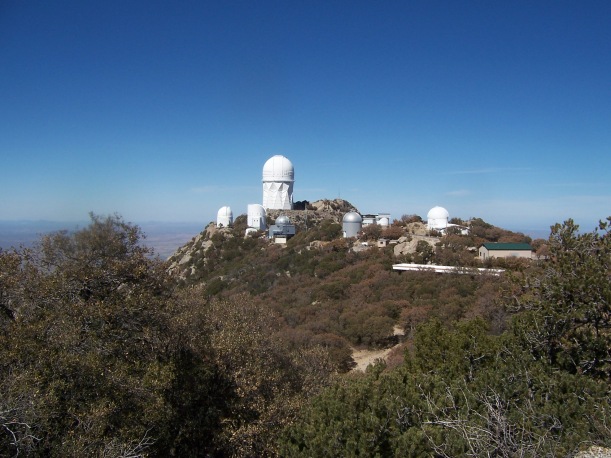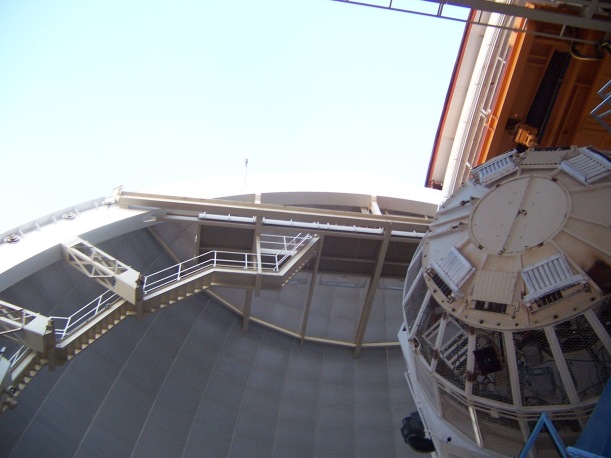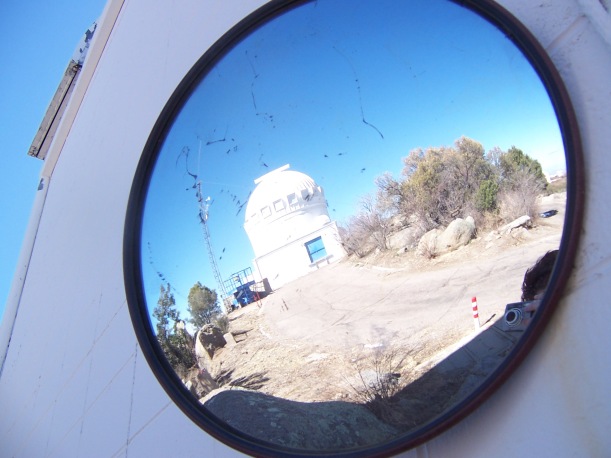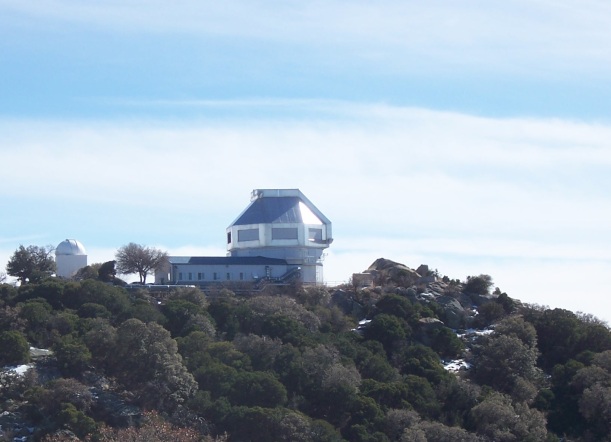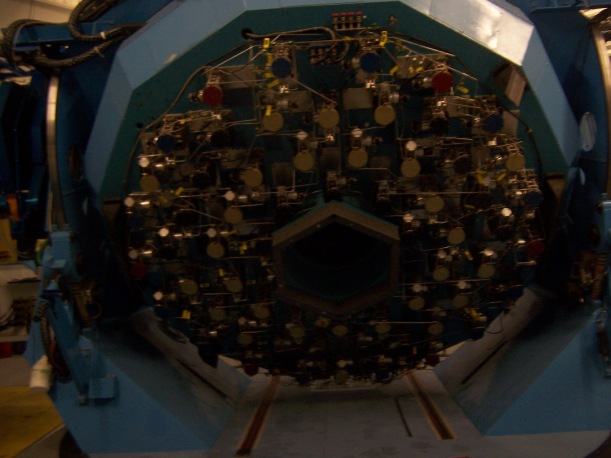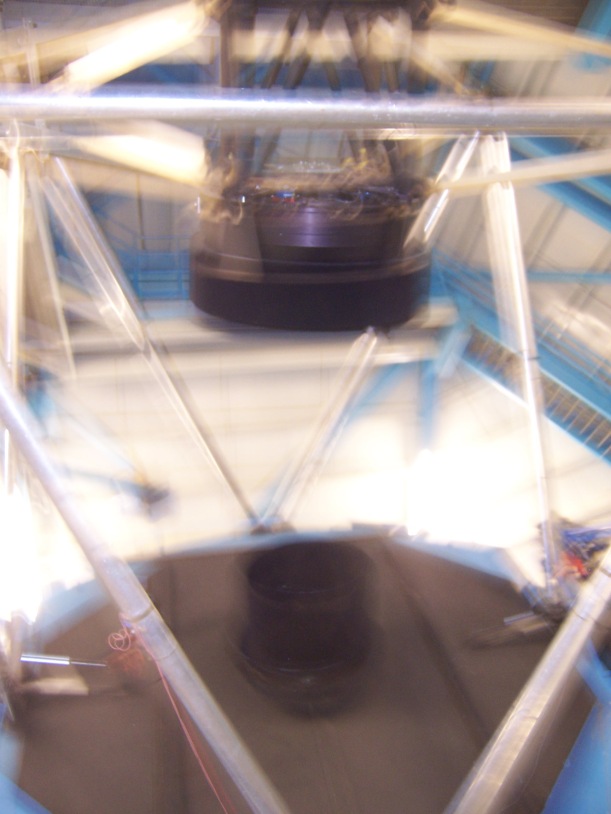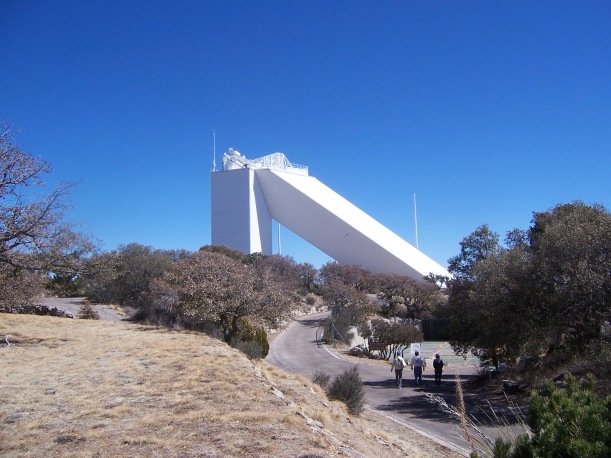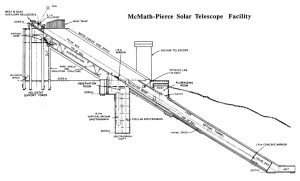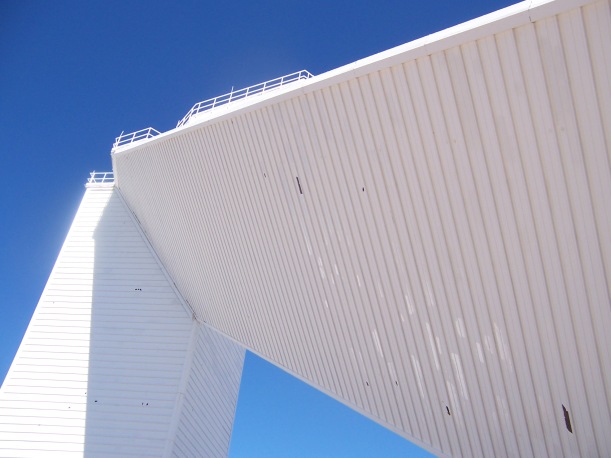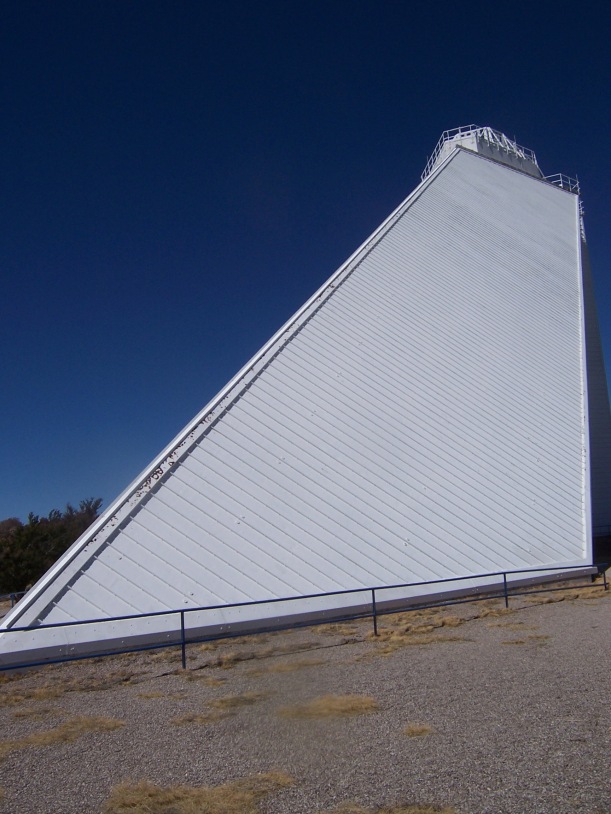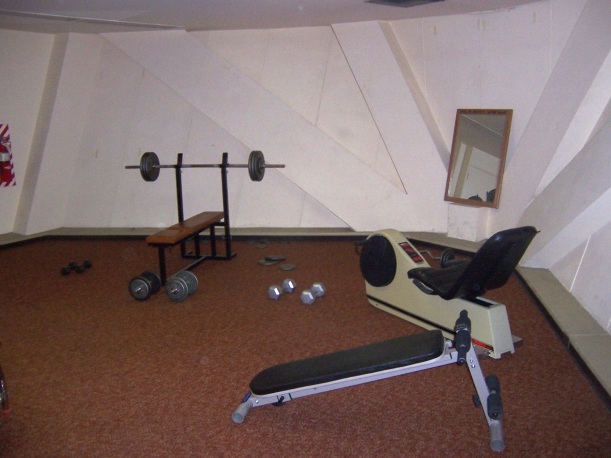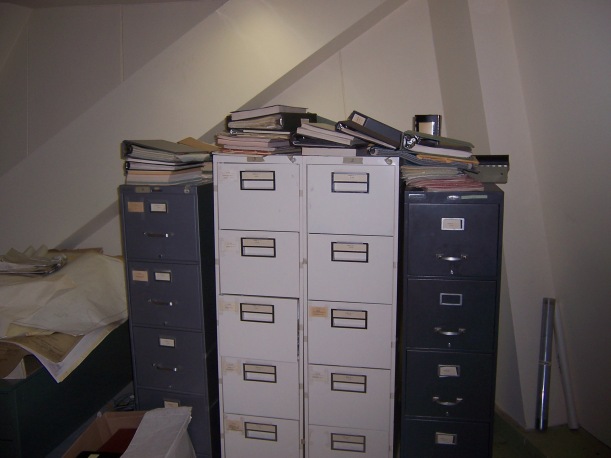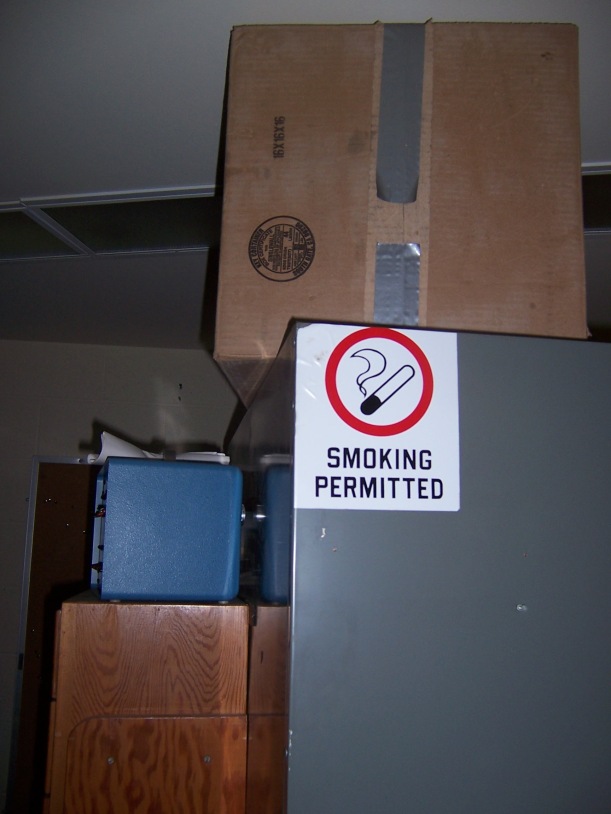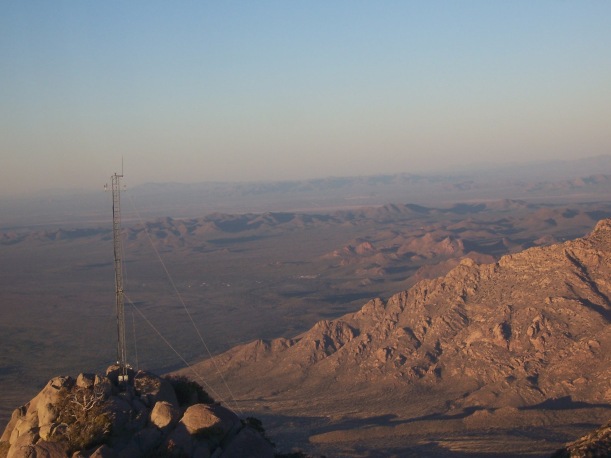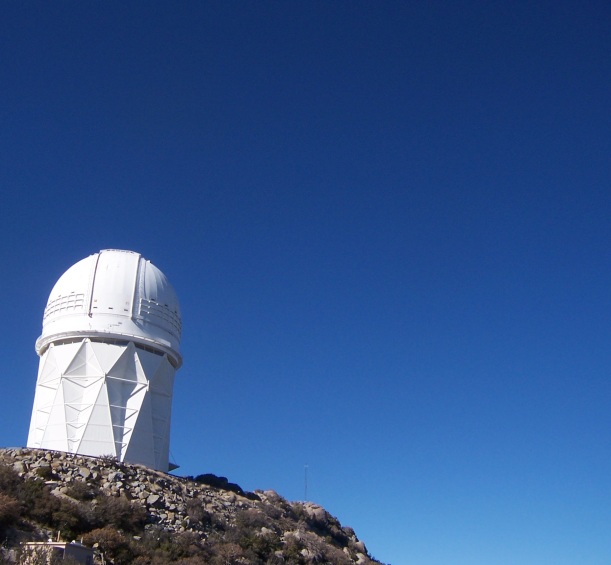If you were looking for a 32-minute video about the dilemmas that faced celebrated physicist Max Planck as the German science academe fell under the control of the Nazi party in the 1930’s, this is the one for you. Science historian Kathy Joseph expounds, rivetingly, on how Planck, a major leader in the development of quantum physics and beloved national figure, wrestled with how much public opposition he could wisely muster to the regime. Initially convinced that the buffoonish right-wingers who came to power in 1933 were a temporary blip, he did his best to preserve the continuity of the German physics community and protect Jewish scientists under his responsibility as president of the Kaiser Wilhelm Society (predecessor to the institution bearing his name). It is striking that while he miscalculated the course of the fascist movement in some ways, it seems unlikely that there is much he could have done differently to oppose their oppressive policies.
Category Archives: Science
Kramschublade Clam Cram

It’s time for a rustic assemblage of miscellany.
I wanted to use a clever name for a running series of miscellaneous hodgepodge so I thought “there’s probably some zany Germanic compound word for a collection of random artifacts. It’ll be a translation of a common thing that contains random items.” Well, as you may have guessed, it is kram schublade, literally, ‘stuff compartment’ in German. Despite the length and fun to say, it doesn’t appear to be a well-celebrated term. The Germans are very efficient when it comes to junk storage, one assumes, and people who store their junk this way are probably socially ostracized.
It seems like it’s supposed to be two words, really, but compound words are more fun. And now that summer is on the way and people are getting vaccinated, what better time to cram some clams? (Where by “clams” I mean “miscellaneous information,” that is.)
Ernst Thälmann Island

Bring me the head of Ernst Thälmann!
And speaking of German, East Germany! There is an oft-repeated geography curio that goes like this: a small uninhabited island off the coast of Cuba was ceded to East Germany back when there was an East Germany as a gift between allies. When East Germany ceased to exist, the reunification treaty didn’t specifically mention this island, so, by implication, the German Democratic Republic lives on there, a smoldering ember of a once mighty Eastern Bloc.
It’s an appealing sort of myth–that some geographic technicality undoes a basic fact about the world that most people think they know. In this case, the technicality itself isn’t true: the “gift” that Cuba made was only ever in spirit, never a formal thing. They just did a little renaming ceremony so that the diplomats could get a picture together for the newspaper. The Cubans renamed their uninhabited isle after Ernst Thälmann, a German communist who opposed (and was eventually murdered by) the Nazis, and “ceremonially” gave it to them and erected a bust of the man himself on the beach.
But it is worth observing that even if it were “true” it wouldn’t really be. Things like the existence or non-existence of countries isn’t based on deciphering obscure bits of information, they’re based on mutual understanding, which is sort of the opposite. Unlike a question like “how many atoms make up the moon?” which has a precise, real answer, there is no cosmic ledger that says which countries exist and which don’t. They’re based on whether you can get a sufficient number of people to treat them as valid, so even if the architects of German reunification had forgotten about this windswept isle, it wouldn’t mean anything, and the Stasi wouldn’t get to start prowling around the Caribbean, wiretapping coconuts and whatnot.

Cash rules everything around me. [Ed: this graph is technically extrapolated from low-wage worker statistics specific to several urban localities, but proportions ought to be broadly true.]
Wage theft is the most common form of stealing in the US. That is, companies underpaying workers what they are owed. And because of the obvious difficulty in bringing legal challenges against an employer, nearly impossible to redress.
An Epidemic of Wage Theft Is Costing Workers Hundreds of Millions of Dollars a Year
Human-Made Stuff Now Outweighs All Life on Earth — Scientific American
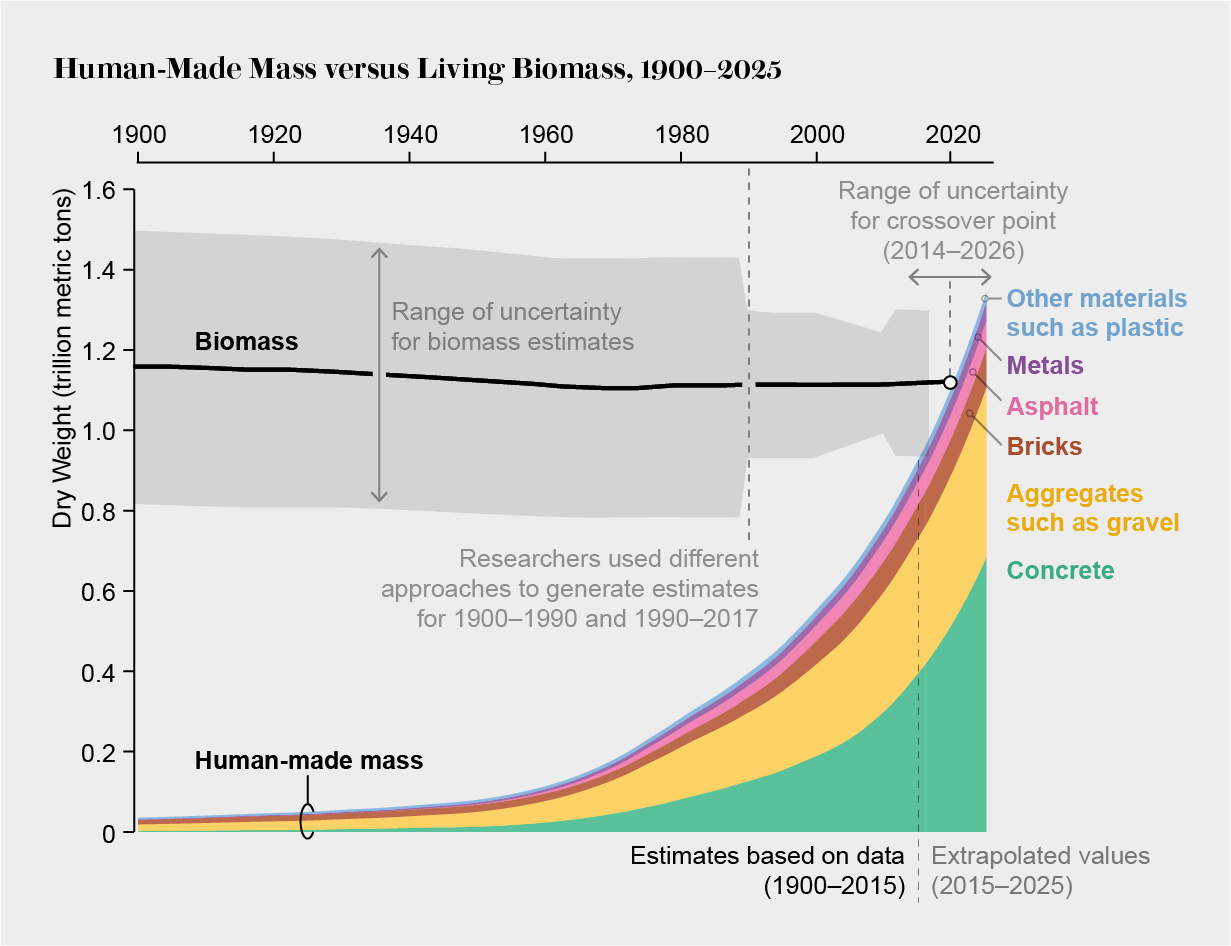
Credit: Amanda Montañez; Source: “Global Human-Made Mass Exceeds All Living Biomass,” by Emily Elhacham et al., in Nature. Published online December 9, 2020
The implications of these findings, published on Wednesday in Nature, are staggering. The world’s plastics alone now weigh twice as much as the planet’s marine and terrestrial animals. Buildings and infrastructure outweigh trees and shrubs. “We cannot hide behind the feeling that we’re just a small species, one out of many,” says study co-author Ron Milo, who researches plant and environmental sciences at the Weizmann Institute of Science in Israel. […]
He and his team had previously published an estimate of the amount of biomass on Earth, which led to the question of how it compared with the mass of artificial objects. Emily Elhacham, then a graduate student at the Weizmann Institute, led the effort to pull together disparate data sets on the flow of materials around the world. The researchers found that human-made, or anthropogenic, mass has doubled every 20 years since 1900. Total biomass remained more stable in that time period, though plant biomass has declined by approximately half since the dawn of agriculture some 12,000 years ago. The team estimates that anthropogenic mass crossed over to exceed biomass this year, plus or minus six years. […]
Whatever the moment when humanity’s production eclipsed nature’s, the study points to a larger narrative in which humans are modifying the planet to such an extent that we have created a new geologic epoch called the Anthropocene, says Waters, who has been active in research seeking out geologic markers of this proposed division of time.
On The Search For Planet X (the game)

“Greetings, Earthling. Would you like to play this game I bought?”
Occasionally, I write pieces for Adventures in Poor Taste, a cool site about all things pop culture, and even, sometimes, science! I recently reviewed the hit board game ‘The Search for Planet X‘ which falls squarely into the intersection of those two subjects. And after you check that out, have a look at my buddy Chris’s far more popular columns about X-Men comics.
‘Search for Planet X’ board game simulates real astronomy — by Ryan Michney
What We Leave Behind
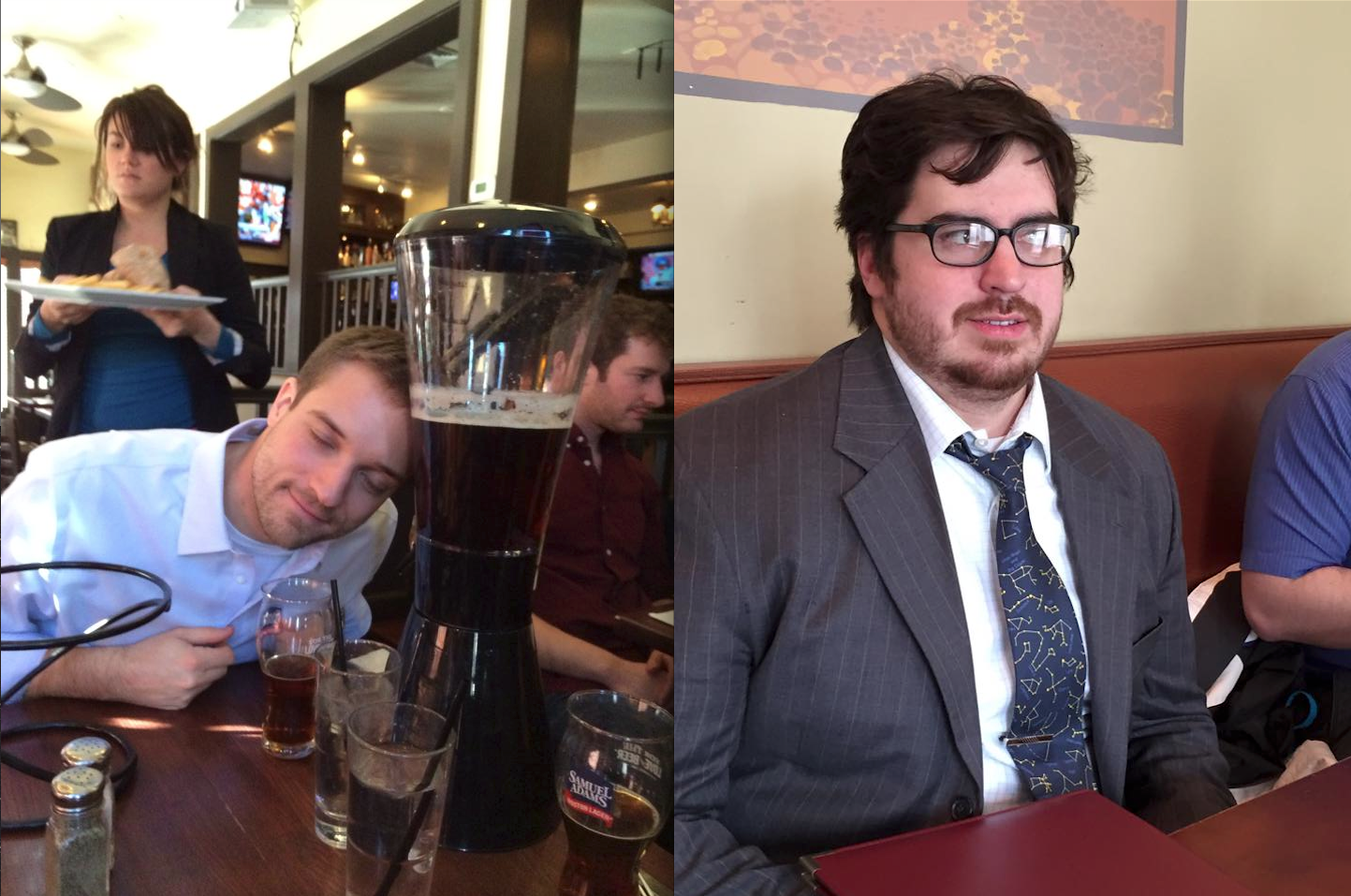
Pictures of David & Ryan, within hours of their defenses. The psychological toll is evident. Photo credit (left to right): Ryan, Dave. (Posted without Dave’s permission.)
As I bragged about in the post I wrote two days after my doctoral defense, one of the things that I was proudest of was slipping a bunch of jokes past my thesis committee. Sure, it was gratifying to receive the approval of other physicists on the culmination of 5 years of research and over a decade of scientific training. But sometimes, at a moment like that, what matters the most is getting some solid goofs preserved in perpetuity upon a dusty shelf in the corner of the esteemed library of my and Dave’s elite Rhode-Island-based university that Aitchbar refuses to mention by name for some reason.
Despite this, my dissertation, with the catchy name Quality-Selected Lensing Analysis of Galaxy Clusters in Subaru Telescope Fields hasn’t gotten the kind of internet heat I would have expected. So I felt like I ought to come up with a primer to point interested parties to the comedy gold. You, dear reader, can be assured that these things are funny, because they have been approved of by astrophysicists in terms of their scientific content. As much humor writing is.
So here’s a rundown for someone who might want to skip all the way more interesting astrophysics parts. This is the link to that dusty library’s online pdf. Here’s the rundown:
I Wrote A Book
Like my co-blogger, I recently, finally, finished my physics thesis. Mine took 1.333(…) years more than his because: (a) I started with my research group in my 3rd year of grad school (instead of the summer before our 1st, like he did), (b) I did all sorts of distracting/fulfilling outreach activities for funding over the course of my years at [Semi-Prestigious East Coast University You Can Find by Googling My Name Or Looking at My Mini-Bio and Remembering Which Famous Colleges Are in Rhode Island] which diverted my attention a bit, (c) Because I am a perfectionist who also realizes that he is lazy, and therefore made every bit of code I wrote idiot-proof for the idiot I knew I would be several months after I wrote it (which turned out to be time-consuming but useful, because I was right about that idiot thing), (d) My project ended up being nearly as large as things accomplished by groups composed of dozens of astronomers—but with just me working on it, (e) Dave is smarter than me.
This picture is me pouring champagne after the confirmation (which is always obvious to everyone other than the person presenting their PhD) that it’s all good, and you’re now a Doctor. I am, conveniently, standing in front of a case displaying former department heads. Other than the guy with the cool chemistry setup on the bottom, I’m the only one who got to know that the universe is much larger than the Milky Way and that the Big Bang happened. I mean, it wasn’t a thing I discovered myself, but it’s still weird.
With one day of distance from this experience I have two major observations. The first is that the passage of time has expanded drastically since the day, weeks ago, when I submitted my dissertation. My perception of time was strongly affected by how much I’d added to my thesis, and when I spent a few days getting something to work, but didn’t contribute pages to it, I felt like I was stuck in a moment and I couldn’t get out of it. Now that I’m done, time is again like it was when I was 8 and each new day was a new world of beautiful experiences to be savored. This whole PhD thing happened yesterday and it feels like years.
Secondly is the fact that my reviewers were fine with the several snide remarks and jokes that I sneaked in there. This, in itself, is ~50% as gratifying as the whole doctorate thing itself. I quoted Donald Rumsfeld and Stephen Colbert. I wrote snide footnotes about Albert Einstein and The Dress. And it will all be on a shelf on the [Semi-Prestigious East-Coast University] Library in perpetuity. That is the sweetest victory of all.
And yes, that is a tie with constellations on it. Because I’m a fucking astrophysicist.
Eponymity in Physics
This is a re-post of a piece I wrote on my old blog, Topography of Ignorance, back in 2007. It’s a list I compiled of the types of things you could get named after you that come in the form [Name][Type of thing], as in the word “Law” from “Moore’s Law.” There are the obvious ones like “equation” but the unusual terms are more interesting because there might be only a single example. The title is itself an adaptation of an obscure word, eponym, which I loosely interpreted to mean “anything named after someone.” I don’t think it’s a real word, and using it probably confused readers (it also could have confused them that it’s basically just a massive list with very little prose). To preserve the classic 2007 “feel” of the original post, I’m keeping the poorly-chosen title and format. Plus, lists are now back in a big way! (What with your Buzzfeeds et al.) So it seemed like an appropriate time to bring it back. Will animate with Jennifer Lawrence GIFs as soon as I’m able…
~~~~~
 A physicist wanting to make an impact on the field most often imagines his or her name attached to an Equation, or a Theory. Or even, if they really want to move mountains, a Law. I have no idea what mathematicians think about, but I would assume that they are hoping to come up with Theorems and Conjectures. Of course, not everyone is an Einstein or a Kepler, able to remake a subject and declare a Law. But if you carve out a niche for yourself, or invent a novel way of dealing with a certain topic, you’re virtually assured of getting something. For an elegant discovery, you could have an Angle named after you, or a Number. Or in a more bizarre direction, a Sea or Paradox. de Sitter has an entire Universe! Me? If I could become the first person since Isaac Newton with an eponymous Bucket I would consider myself a success. There are so many strange things you could find named in your honor that I have compiled an extensive list of them with some examples namesakes on the right-hand side.
A physicist wanting to make an impact on the field most often imagines his or her name attached to an Equation, or a Theory. Or even, if they really want to move mountains, a Law. I have no idea what mathematicians think about, but I would assume that they are hoping to come up with Theorems and Conjectures. Of course, not everyone is an Einstein or a Kepler, able to remake a subject and declare a Law. But if you carve out a niche for yourself, or invent a novel way of dealing with a certain topic, you’re virtually assured of getting something. For an elegant discovery, you could have an Angle named after you, or a Number. Or in a more bizarre direction, a Sea or Paradox. de Sitter has an entire Universe! Me? If I could become the first person since Isaac Newton with an eponymous Bucket I would consider myself a success. There are so many strange things you could find named in your honor that I have compiled an extensive list of them with some examples namesakes on the right-hand side.
First, some of the most common:
| Equation | |
| Formula |
|
| Law |
|
| Theorem |
|
| Theory |
|
| Hypothesis |
|
| [A Unit] | Newton, Gauss, Joule |
| [A Constant] | Planck, Boltzmann |
| Function | Riemann-Zeta, Bessel |
| Effect | Mössbauer, Stark, Bohr, Gunn-Peterson, etc. |
And then of course, there are rarer terms. These trend very roughly from less to more obscure.
| Field | Fermionic, Bosonic, Higgs |
| Matrix | Kobayashi, Cabibbo |
| Relation | Heisenberg, Tully-Fisher |
| Principle | Copernican, Pauli Exclusion |
| Model | Schwinger, Bohr |
| Method | Schrödinger |
| Postulate | Planck, Weyl |
| Approximation | Born |
| Space |
Minkowski, Fock, Hilbert |
| Metric | Friedmann-Robertson-Walker, Minkowski |
| Distribution | Wigner, Bose-Einstein, Fermi-Dirac |
| ___-on | Fermi, Bose |
| ___-ian | Laplace, Hamilton, Riemann |
| Notation | Dirac |
| Potential | Coulomb, Yukawa |
| Action | Stueckelberg, Proca |
| Inequality | Minkowski, Bell |
| Limit | Chandrasekhar |
| Tensor | Riemann |
| Scalar | Ricci |
| Gauge | Newtonian |
| Diagram | Feynman |
| Radiation | Cherenkov, Hawking |
| Cycle | Carnot, Born |
| Interpretation | Bohm, Copenhagen |
| Paradox | Einstein-Podolski-Rosen, Olber, Fermi |
| Problem | Rabi, Fermi |
| Experiment | Milikan Oil Drop |
| Spectrum | Mössbauer |
| Conjecture | Witten |
| Interaction | Yakawa |
| Amplitude | Feynman |
| Operator | d’Alembert |
| Particle | Higgs, Planck |
| Neutrino | Majorana, Dirac |
| Motion | Brownian |
| Length | Jeans |
| Number | Avogadro, Chandrasekhar, Euler |
| Surface | Fermi |
| Condensate | Bose-Einstein |
| Radius | Schwartzschild, Bohr |
| Convention | Einstein Summation |
| Transform | Forier, Laplace |
| Series | Balmer, Lyman |
| Line | Lyman, Balmer |
| Rules | Slater |
| Scattering | Compton, Rayleigh, Thompson |
| Variable | Cepheid, RR Lyrae |
| Diffusion | Bohm |
| Diffraction |
Bragg |
| Junction | Josephson |
| Expansion | Taylor |
| Manifold | Riemann |
| Topology | Picard |
| Mechanism | Higgs |
| Peak | Wein |
| Test | Tolman surface brightness |
| Repulsion | Coulomb |
| Epoch | Planck |
| Parameter | Hubble |
| [An Element] |
Einstein, Fermi, Curie, Mendeleev, Lawrence, Nobel |
| Time/Mass/Energy/Temperature /Density/Power/Current/Length |
Planck |
| Energy/Level/Hole/Velocity /Temperature |
Fermi |
| Wavelength | de Broglie |
| Boson | Higgs |
| Profile | Hernquist |
| Criterion | Landau |
| Rigidity | Born |
| Cross-section | Thompson |
| Zone | Brillouin, (also see, List of Zones) |
| State | Hartle-Hawking |
| Angle | Weinberg |
| Universe | de Sitter, Lemaître |
| Sea | Dirac, Fermi |
| Magneton |
Bohr |
| Splitting | Zeeman |
| Forest | Lyman-alpha |
| Blob | Lyman-alpha |
| Swindle | Jeans |
| Trough | Gunn-Peterson |
| Window | Gamow |
| Cage | Faraday |
| Engine | Carnot |
| Bucket | Newton |
| Tuning Fork |
Hubble |
| Golden Rule | Fermi |
| Pancake | Zel’dovich |
| Brain | Boltzmann |
| Demon | Maxwell |
| Cat |
Schrödinger |
If anyone else is able to repeat that last one, I will be highly impressed. I would also like to point out that the Higgs boson may be the only phenomenon or concept that has two namesakes, since the term boson originally comes from Satyendra Bose! If you can think of anything else let me know and I’ll add it.
Update:
Pairs . . . . . . . . . . . . . . . . . . Cooper
Focus . . . . . . . . . . . . . . . . . . Cassegrain, Nasmyth
In which I answer the evolution questions of hopeless people living without access to the internet
Buzzfeed has a collection of “questions”/smirking ignorance from people who consider themselves creationists. Since these are all such pat, easily-answerable questions I can’t resist taking a break between doing science, and helping teach science to people who are interested in learning it, to throw up a few answers to the questions of people who aren’t. None of the actual science ones ought to take a minimally interested person more than 30 seconds to find online, but since I can do each in 5 sec or less, let’s all save some time together! (Spelling mistakes faithfully transcribed!) (Smirkiness levels matched!)
1. “Bill Nye, are you influencing the minds of children in a positive way?”
I’m not him, but yes he is.
2. “Are you scared of a Divine Creator?”
No
3. “Is it completely illogical that the earth was created mature? I.e. trees created with rings… Adam created as an adult…”
Yes.
4. “Does not the second law of thermodynamics disprove Evolution?”
No.
5. “How do you explain a sunset if their is no God?”
Earth’s rotation.
6. If the Big Bang Theory is true and taught as science along with evolution, why do the laws of thermodynamics debunk said theories?”
They don’t.
7. “WHAT ABOUT NOETICS?”
I’ll try anything once.
8. “Where do you derive objective meaning in life?”
From being right about science.
9. “If God did not create everything, how did the first single-celled organism originate? By Chance?”
By natural processes. Also, ‘chance’, given millions of years and the right conditions, guarantees such a thing occurring. Also also, not fully understanding an event doesn’t imply that God did it.
10. “I believe in the Big Bang Theory… God said it and BANG it happened!”
OK
11. “Why do evolutionists/secularists/huminists/non-God believing people reject the idea of their being a creator Gob but embrace the concept of intelligent design from aliens of other extra-terestrial sources?”
They don’t, you’re thinking of the film Prometheus.
12. “There is no in between… the only one found has been Lucy and there are only a few pieces of the hundreds neccessary for an ‘official proof’.”
The non-existence of “transitional” fossils is a myth. There are thousands of pre-human fossils. I will forward your objection to the Official Proof Commission.
13. “Does metamorphosis help support evolution?”
The Metamorphosis is a surrealistic short-story by Franz Kafka. Published in 1915, this German novella depicts the unexplained transformation of salesman Gregor Samsa into a horrific cockroach-like insect and his efforts to deal with his mysterious and terrifying condition.
14. “If Evolution is a Theory (like creationism or the Bible) why is Evolution taught as fact.”
‘Theory’ and ‘fact’ are not mutually incompatible concepts. Also, the Bible is a book, not a theory.
15. “Because science by definition is a ‘theory’— not testable, observable, nor repeatable’ why do you object to creationism or intelligent design being taught in school?”
See #14. Theories are all of those things and evolution has been tested and observed in a myriad of ways.
16. “What mechanism has science discovered that evidences an increase of genetic information seen in any genetic mutation or evolutionary process?”
Not an expert here but I’d venture the existence of forms of life with less complex genetic code. Also, if this is a reference to entropy, it only has to increase overall within an environment, not within every organism.
17. “What purpose do you think you are for if you do not believe in salvation?”
I’m pretty decent at parallel parking.
18. “Why have we found only 1 ‘Lucy’, when we have found more than 1 of everything else?”
There are literally thousands of other hominid fossils.
19. “Can you believe in ‘the big bang’ without ‘faith’?”
I do. But I ‘believe’ in it because there is evidence that it happened. If new evidence showed that it didn’t, I would change my mind.
20. “How can you look at the world and not believe Someone Created/thought of it? It’s Amazing!!!”
Cool story.
21. “Relating to the big bang theory…. Where did the exploding star come from?”
The big bang was a star exploding? I don’t even…
OK, these have been rough. Just one more left. Hopefully it’s not a super-dumb misunderstanding of one of science’s most important and beautiful theories that anyone can understand if they bother to take a couple seconds on the internet or ask a grown-up.
22. “If we come from monkeys then why are there still monkeys?”
Gosh, that’s a good one. That really sounds like a thoughtful new angle on this whole issue that biologists surely haven’t considered. I haven’t lost patience with this exercise or anything.

You know what? This cactus here is like, really old and wise and stuff. He says he’s been around hundreds of millions of years and he’s seen pretty much all of human history so why don’t you just get really close to his knowledge port and he can whisper it to you. Don’t be shy. Yeah, right in there…
Where’s my Planck Beach Ball?
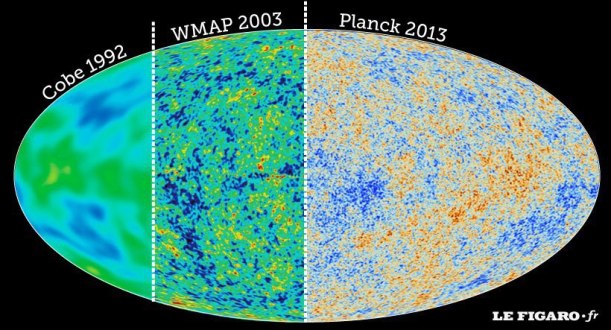 Some years ago, on my old blog, I wrote about a promotional beach ball with the WMAP Cosmic Microwave Background measurements printed on it that was distributed mysteriously to cosmologists. It was a kind of puzzling move since it was given, seemingly at random, to astrophysicists who were certain to know about WMAP anyway, and was not actually purchasable by members of the public. My undergraduate advisor, for instance, received one in a plain manilla envelope shortly after the results were published, and like everyone else who got one, blew it up and put it in his office. It didn’t make him rely on WMAP more or less, he already knew all about the experiment (just like everyone else who cares about the contents of the universe), and it’s primary function seemed to be sitting in the background of pictures taken for faculty webpages. It became so ubiquitous among cosmologists that it’s been featured in shows like, appropriately, The Big Bang Theory. There’s even an interview with the ball’s creator on the Goddard site.
Some years ago, on my old blog, I wrote about a promotional beach ball with the WMAP Cosmic Microwave Background measurements printed on it that was distributed mysteriously to cosmologists. It was a kind of puzzling move since it was given, seemingly at random, to astrophysicists who were certain to know about WMAP anyway, and was not actually purchasable by members of the public. My undergraduate advisor, for instance, received one in a plain manilla envelope shortly after the results were published, and like everyone else who got one, blew it up and put it in his office. It didn’t make him rely on WMAP more or less, he already knew all about the experiment (just like everyone else who cares about the contents of the universe), and it’s primary function seemed to be sitting in the background of pictures taken for faculty webpages. It became so ubiquitous among cosmologists that it’s been featured in shows like, appropriately, The Big Bang Theory. There’s even an interview with the ball’s creator on the Goddard site.
Despite being the kind of thing that would help promote the mission, NASA didn’t sell them, but did devote a website to it for some effing reason. I was jealous, and liberated one from captivity, as I wrote about here:
I am now free to disclose that I have triumphed over the forces allied against me– the beach ball website that mysteriously refuses to sell it, the people who said I would never amount to anything, the journals that keep rejecting my groundbreaking work on the anisotropy of CMB beach ball distribution, everyone. I have, indeed, obtained the ball:
I can’t go into the specifics of where it came from, but let’s just say that a certain physics department who could never appreciate it as much as I do had a habit of carelessly leaving it in a usually unlocked room full of other neglected items, which I thoughtfully did them the favor of not stealing
Despite bragging about my larceny online, I had effed the eff off down to Providence by then, and the beach ball authorities never caught up to me.
Now, years later, the long awaited Planck results have been released; a refinement of the anisotropy measurements done by WMAP with higher resolution, a slightly lower Hubble Constant, and an older universe with more matter. But there’s something missing: a beach ball with the radiation from the early universe printed on it. Well, that and the polarization results that aren’t coming out until next year. Sure, Planck is an improvement on the accomplishments of the WMAP probe, but it’s a little hard to take them seriously when they aren’t willing to put their data on the surface of an inflatable ball.
It was NASA that came up with the WMAP ball, while this time it’s the European Space Agency running Planck— though NASA does have some involvement. If NASA’s outreach division hadn’t just been decimated by the sequester, this could be their contribution. Instead it’s up to the Europeans. Get it done ESA/Planck!
Observations on Observing
Two weeks ago I went down to Kitt Peak National Observatory in Arizona with my advisor to do some observing. Physics as a discipline isn’t really prone to sending students on trips (other than to conferences or to work with collaborators on a multi-university project), and astronomy only for observing trips like the one I just did, and consequently it was only the second time I’d gotten to travel for school/work/whatever grad school is. I did more theoretical stuff when I was an undergrad and I’ve been using archival data since I began in observational astronomy so going anywhere just hadn’t happened yet. This semester though there has been a lot of observing activity in our group, so even though it isn’t specifically connected to my thesis work, we’ve needed people to help out. In this case for a project involving star formation rates within galaxy clusters.
The local environment within clusters of galaxies (presumably some aspect of its density at the point in question) has an effect on the star formation rate within the galaxies. Since there haven’t been a ton of observations of the lower rate, fainter, galaxies in clusters the idea was to come up with a method of imaging them so we could gain some insight into how many stars are forming there and why. We chose a few known galaxy clusters that are at a specific distance such that the primary emission wavelength is redshifted to be just within a narrow-band filter on the MOSAIC imager of the telescope we used (the Mayall 4-meter). Then, by comparing the difference between the narrow and wide band filters, we could pick the galaxies that were at this distance out from the background, and figure out their rate of star formation.
So that’s basically the science justification for what we were up to. Like I said, it isn’t specifically what I’ve been working on myself (though I do study galaxy clusters) so when I say “we” I really meant “the PI and my advisor” (at least in the last paragraph).
So back to focusing on me.
I had to leave from Boston at like 9am, so even though I knew I’d be up all night observing, I had to get up at like 6 am and spend most of the day in seats that weren’t designed for 6’1”, leggy brunettes like myself. We basically had to rush to get there in a timely manner, the observatory is about an hour outside Tucson, and my flight didn’t get in there until about 90 minutes before we had to get down to business
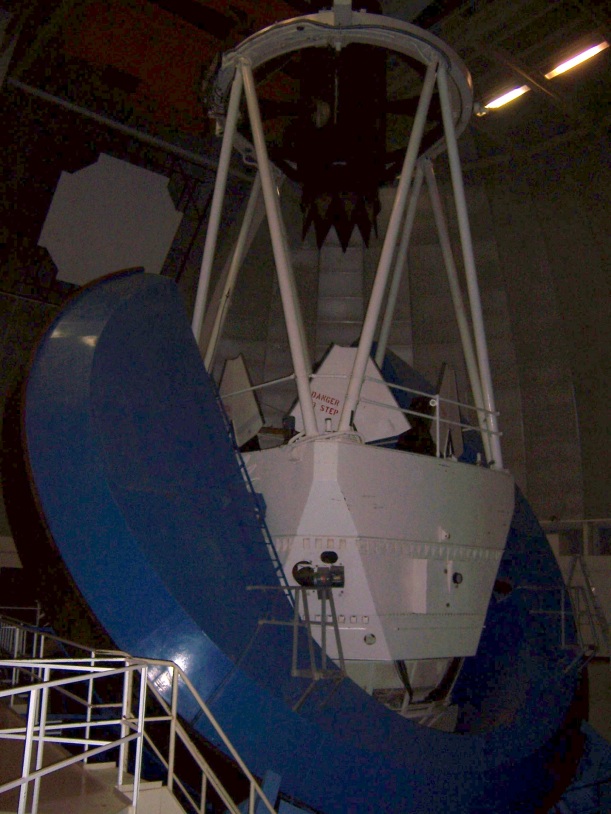
- For scale, think of each letter as being the height of an average human. It would be incorrect, but think about it anyway.
The telescope we were using for this project was the Mayall 4-meter at Kitt Peak. It’s a beast of an observatory— the telescope, the dome it’s in, and the structure itself, are all enormous. At least, they feel that way considering that it’s about 15 stories high and there are usually only 3 people working in there. It was built in the early 70s when the thinking was that getting any height above the ground was an improvement in seeing (the clarity of images), and so even though it was already on top of a mountain, they deliberately made it wicked tall. And to accommodate the the size of the telescope’s focal length (as you can see above) the inside of the dome, and therefore the footprint of the building had to be large as well. As it turned out, it really didn’t matter how tall it was, and in fact, giving it this massive structure caused wind coming up the side to shake the telescope a bit, which is obviously bad. Nonetheless, it’s a great instrument, and powerful enough to accurately resolve some faint galaxies.
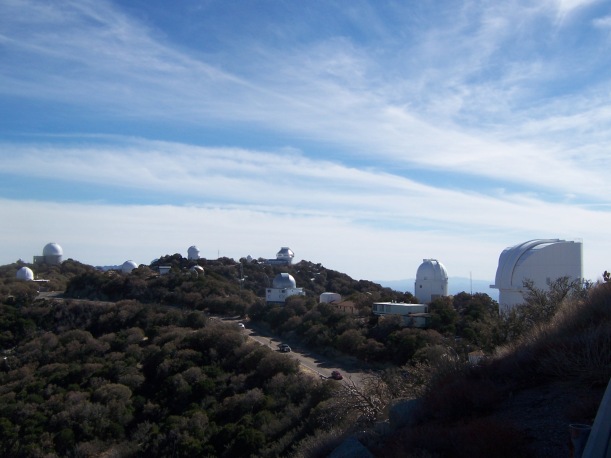
Reverse view from the 4-meter. You can see WIYN (the shiny metal one), the 2-meter, and a surprising amount of traffic for a mountaintop.
The first night was really painful. After having been up for about 30 hours in a row, (especially when a lot of that time consists of traveling-while-tall) everything in my body hurt, and for about an hour around 4 am my consciousness was flipping on and off like a light switch. So good job there, self. And coming out at about 6:30 am onto a freezing, surprisingly windy mountaintop was fairly painful as well. Fortunately, it was worth it since we got so much data that night. My advisor, despite working around the clock and having a couple kids, has that Margret Thatcher superpower where he only needs a few hours of sleep every day (his approval numbers are better among Scottish miners too). So luckily for us, he breezed through the all-nighter. If it had just been me, I probably would have collapsed on the controls around 4:30 and caused some kind of comical mishap.
As I said in the little science part, in addition to two common filters, we were taking images in two narrow-band filters which required us to have the shutter open for 10 or 20 minutes at a time. Once you’ve gotten set up and conditions are basically constant, and you are doing a 5-image pattern of 20 minute exposures, it definitely gives you some time to think. So I thought about how to write a python script sorting data based on header information in the files I’m using, and since I was so tired and achy, it took about 5 times as long as it should have, and involved deep thoughts about how quotation marks in certain contexts cause syntax errors.
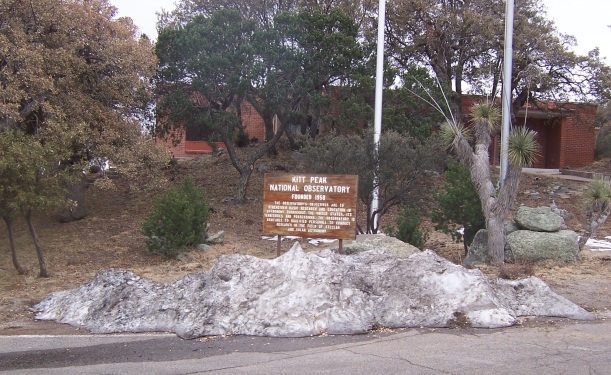
Usually when you go from New England to Arizona in the winter, it means you don’t have to look at dirty snow.
One of the cool things though about the ultra-long exposures is that they are actually long enough to detect asteroids. You see all the usual stars and galaxies, and since the exposure is so long, a higher than average number of cosmic rays, but if you look closely, there are numerous little streaks, all going in the same direction. The Earth’s motion relative to the asteroids is such that over the course of 20 min we have moved far enough relative to them that they’ve steadily moved through the background. On the third night we accidentally set the telescope to track on an asteroid, and got the reverse effect. You pick a bright guide star on each exposure and it helps the instrument to follow the field through the Earth’s rotation. It was a 13th magnitude asteroid, and the operator understandably mistook it for a star, so after 10 minutes when we saw the image, everything was streaked out, with the asteroid (and presumably all the other asteroids) looking like stars. Needless to say, there isn’t much you can do with that image.
We were there for 4 nights and semi-fortunately, only got good data on 2.25 of them. The first was clear, the second was cloudy and we packed it in around 1am. The third it was beautiful again and we finished up two of our three clusters, and on the last night, we got just enough to deepen our exposures of one cluster. Of the clusters we wanted to see, the first was up by sunset at ~7pm, while the second only came up at 1am or so and the third a little after that. We just barely got enough for the first two. The first night we got some images of the 3rd cluster (I think) but not in enough different bands to be useful for this project.
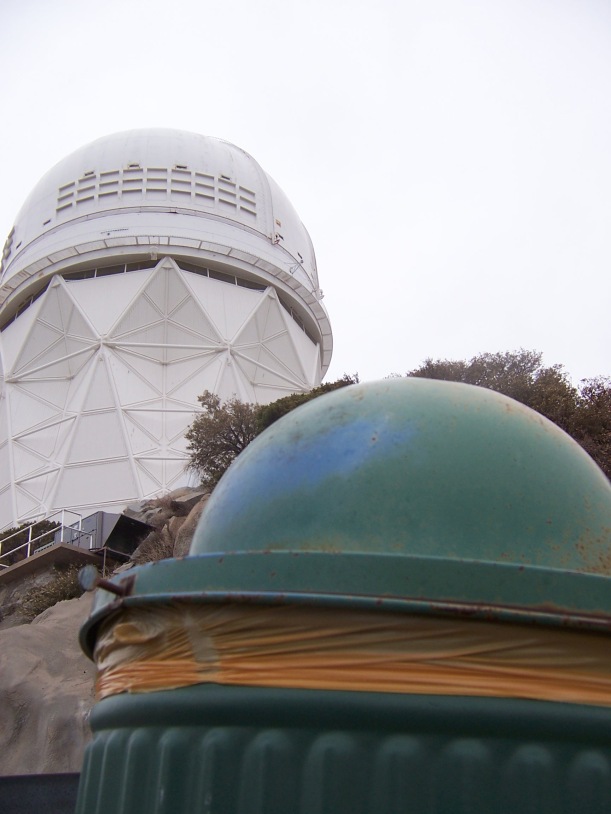
A metaphor? For the current state of investment in basic research? Or something. It looks artistic though doesn’t it?
Since I mostly work with lots of raw data, as I said, this was my first time literally operating a world-class instrument. If you don’t count outreach activities (I can put together our portable hydrogen-alpha solar telescope blindfolded like the guy in Full Metal Jacket), or TA-ing (using some kind of 1843 brick observatory full of leaves and ghosts to show undergrads that Saturn actually has rings), my experience with these kinds of telescopes was on the back-end, dealing with the imagery itself. It was somehow surprising that to take images you simply type a command into a little unix terminal window and hit “enter.” The first few times you do it you think “that’s it?” It doesn’t seem possible that this is all it takes to photograph these enormous galaxies billions of lightyears away from Earth (and simply odd to have a typed command control a physical object), but of course, years of work went into designing everything and writing the software and wiring the control system… it’s just a thing that is easy to forget in the moment.

The control room, from which, as you may guess, the telescope is controlled. And screens are looked at.
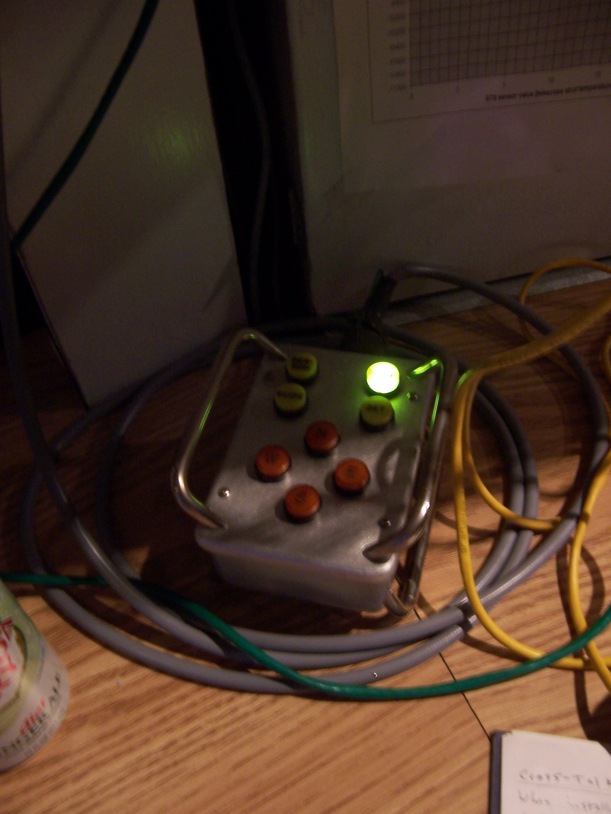
This paddle that can move the telescope was next to me most of the time we were observing. Even though it is almost never used, they like to leave it plugged in and in the middle of the observer’s workspace. What could possibly go wrong?
Although the operator controls the telescope pointing, this paddle could just move the telescope over a few inches at any moment if I hit it. Good to know it was powered up and plugged in. Other than the possibility of ruining an exposure by accident, the work area was actually pretty nice. Non-astronomers who I mentioned the trip to all assumed that we were exposed to the elements somehow—that we were actually inside the open dome structure. I’m glad that we weren’t, since other than stray light getting near the mirror, it was probably about 30 degrees up there, with extremely forceful wind. Astronomy would be brutal if we had to work that way. Instead, we get to stay in a nice, warm, protected control room. Bonus points for the controls on the operator’s side of the room looking like they could have come out of a 1950’s sci-fi movie with gauges and backlit buttons.
After getting enough rest following the first night I set out to wander and look at all the other instruments. There was some slight awkwardness based on the fact that Kitt Peak is enough of a tourist attraction to draw people during the daytime, and though I was there as an astronomer, it isn’t like I’m carrying some “I’m supposed to be here” card that would make me feel less odd about crossing “Staff Only” signs. I mean, I did do that, but I felt weird about it.
We have a strong involvement in the One Degree Imager (ODI) at the WIYN telescope so I headed over to give it a look. Gravitational lensing studies are all about trying to get accurate, resolved, shapes of galaxies, and seeing is often the most important part of doing that. Seeing is defined as the size of stars in the image—stars are so far away that they should be points of light, but the atmosphere spreads them out, and the larger they are, the worse the image is. The adaptive optics in WIYN’s mirror, and the further corrections made by ODI, (which was only installed in the past year), takes those star images in real time and predicatively corrects the atmospheric distortions. So even though it’s not located on top of a giant windy pedestal, it’s a pretty good tool for resolving galaxy shapes. Even though it isn’t a tourist area, I figured that since I’ve been hearing about it for years and helping to write proposals involving it, I was within my rights to barge in and look around. The operator was kind enough to show me around, and despite the fact that it is a comparable instrument to the behemoth I was working in, the entire building was about the size of a large house. Here’s a picture of the adaptive optics behind the mirror that shape it to improve the focus.
And ODI is this stuff:
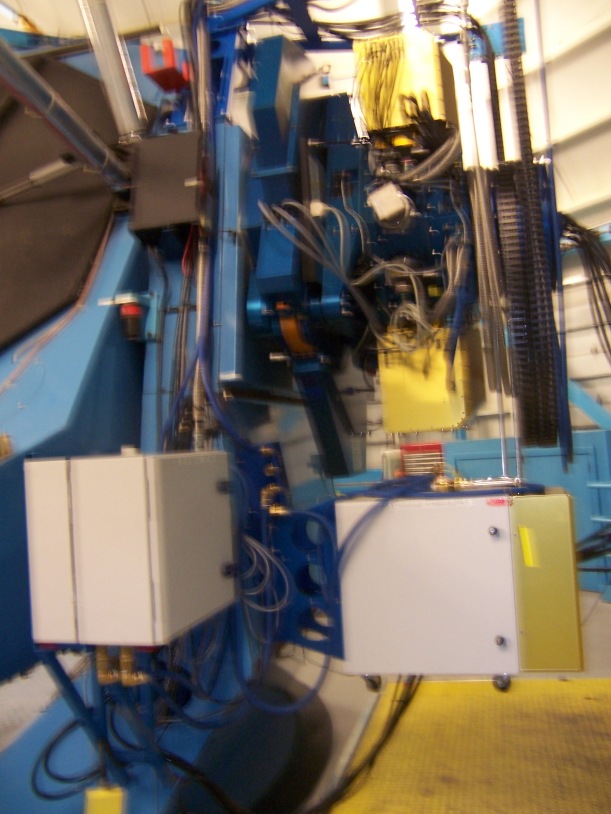
The One Degree Imager, an orthogonal transfer array that stabilizes the image in real-time within the CCD. Taking a blurry photo of it is deeply ironic.
Apparently the instrument is so quiet when it’s moving that they actually put a cowbell on it so the operators could be sure that it was actually changing position. It was over where the ODI equipment is located, but so essential that they evidentally built the new instruments around it, so you can’t actually see it anymore. (I assume that it just happens that they were able to put all the new stuff around it, but I prefer the idea that they considered it so indispensable that some planning went into keeping it there). Oddly, almost all the pictures I tried taking of it came out blurry.
As you can see WIYN clearly creates some special zone of optical clarity for itself that transfers blurriness to all nearby imaging devices.
One of the most visually striking things up on Kitt Peak is the unusually shaped McMath-Pierce Solar Observatory. In terms of astronomical instruments it’s certainly unique. Like an iceberg or the hostility among players on a high school lacrosse team most of it is hidden below the surface. It sends light from the sun far down a long tunnel burrowed into the mountain, then reflects it back and finally sideways into an underground control room. At the time it was built this was the best way of getting magnified images and detailed spectra from the sun. Here’s a schematic:
Not knowing anyone in this field, I resisted the urge to actually go in and see the science area, but I did check out the little tourist booth where you can see the shaft and mirrors and took a ton of artsy photos of this futuristic dystopian setpiece.
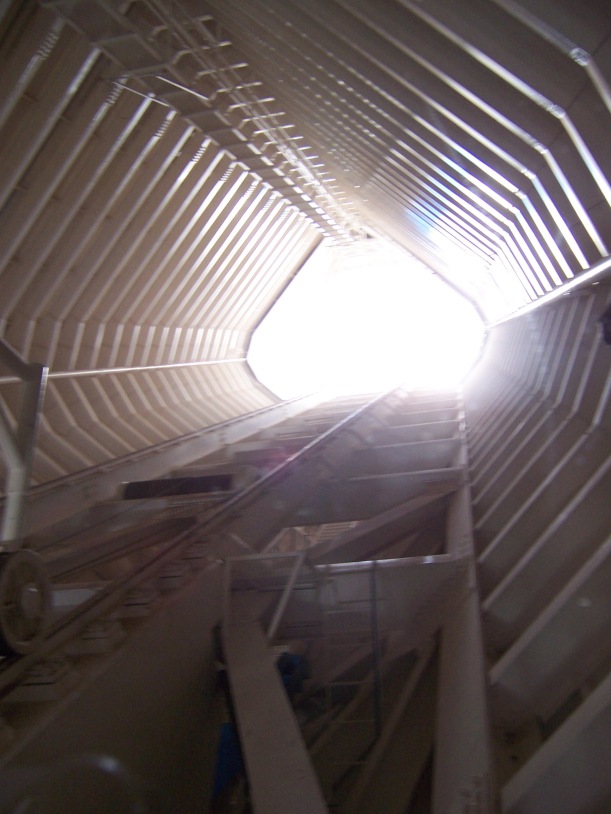
Inside the solar observatory. It’s bright up there, I think I see why they put that hole in the top.

The radio telescope. It’s some distance away from the main area, and operated remotely, so as to accommodate Jodie Foster’s busy schedule.
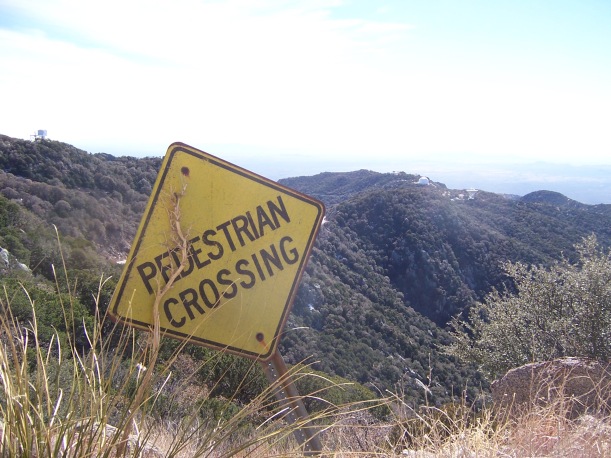
When I took this I thought there was some kind of irony or artistic value in this photo. In retrospect, it is obviously meaningless.
Having done my share of aimless wandering and rested up, the rest of the trip was pretty fun. Unfortunately, the nights when we were able to get data alternated, so the second night we got nothing, the third we got a lot and on the last a storm was approaching so we only got a few hours done. There were points where we just watched the monitor as clouds were passing in front of the guide star, pausing it when it was covered, opening the shutter again when it cleared up, like the world’s most mundane video game.
One of the nights it was cloudy I went wandering around the building to check out the old equipment and aging rooms. It seems as though when it was designed, they envisioned using the building for everything, and since it’s so enormous they have all kinds of spaces there. People kept mentioning that there are creepy dorm rooms somewhere, in a way that implied that although they worked in this building, they weren’t clear on exactly where they were. Since there aren’t any windows, these terror rooms were basically small prison cells—unfortunately I didn’t find them. This is the exercise room, you can see the angular outside wall behind the state of the art exercise stuff:
They also had a bit of stuff left over from the era of photographic plates. Fortunately for us, we now use CCD cameras, but when this telescope was inaugurated it still had the old-fashioned cameras. So there were instruments for measuring sizes of objects and the astrometry between them on the photographic plates, as well as cabinets full of data, back when our data was a physical thing.
Going outside you really do feel like you’re isolated on top of some kind of desert ocean up there. You can’t see any signs of civilization until the nighttime, when little towns in the desert light up. I haven’t spent much time in deserts and the beauty is so striking.
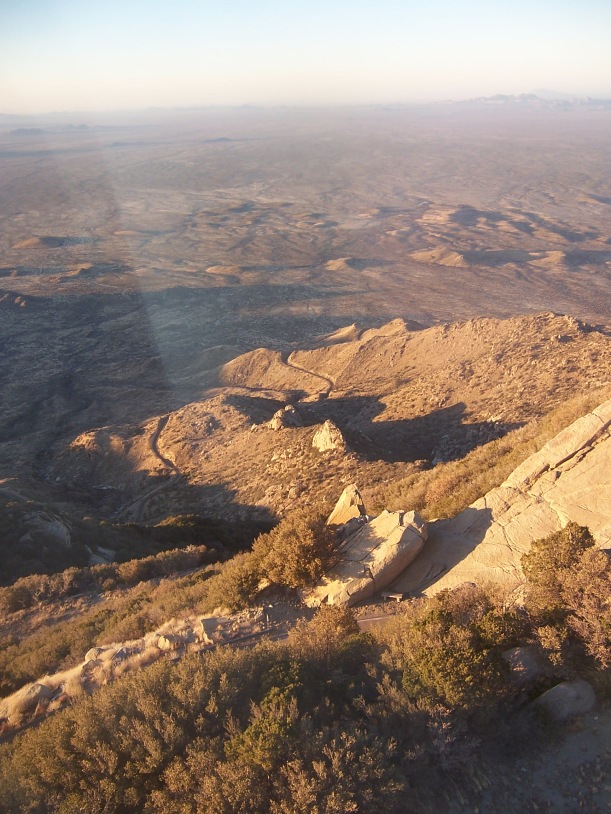
Looking roughly north about an hour before sunset. It doesn’t look that far up in this picture, but it really really is.
In conclusion: telescopes.
